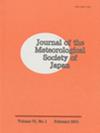ENSO季节变化对东亚地区大气河流活动的影响
IF 1.6
4区 地球科学
Q3 METEOROLOGY & ATMOSPHERIC SCIENCES
引用次数: 13
摘要
大气河流(ARs)是中纬度地区狭窄的水汽输送带,经常对东亚造成巨大的社会经济影响。虽然已有研究表明,冬季前的厄尔尼诺Niño 32发展强烈诱导了东亚夏季AR活动,但厄尔尼诺Niño 33南方涛动(ENSO)从冬季到夏季的季节转变在多大程度上影响AR活动仍不清楚。本文利用大气再分析和高分辨率大气环流模式(AGCM)整体模拟研究了ENSO的季节变化与东亚夏季AR活动之间的关系。与持续或衰减的厄尔尼诺Niño相比,冬季前的厄尔尼诺Niño向夏季的厄尔尼诺Niña的快速转变,通过北太平洋西部上空的异常低空反气旋向北扩展,导致东亚北部发生更多的AR。反气旋向北扩展与大气对海洋大陆和赤道太平洋上空异常凝结加热的稳定响应是一致的。再分析和AGCM模拟结果表明,温带AR发生和环流异常的经向位置有43个差异。这可能是由有限的样本量和/或AGCM偏差造成的,并表明在区域范围内对东亚地区与ar相关的自然灾害风险进行季节性预测仍然是一个挑战。本文章由计算机程序翻译,如有差异,请以英文原文为准。
Impacts of Seasonal Transitions of ENSO on Atmospheric River Activity over East Asia
29 Atmospheric rivers (ARs), narrow water vapor transport bands over the mid-latitudes, 30 often cause great socio-economic impacts over East Asia. While it has been shown that 31 summertime AR activity over East Asia is strongly induced by preceding-winter El Niño 32 development, it remains unclear the extent to which seasonal transitions of El Niño 33 Southern Oscillation (ENSO) from winter to summer affect the AR activity. Here we 34 examine the relationship between the seasonal transitions of ENSO and the summertime 35 AR activity over East Asia using an atmospheric reanalysis and high-resolution 36 atmospheric general circulation model (AGCM) ensemble simulations. A rapid transition 37 from preceding-winter El Niño to summertime La Niña results in more AR occurrence over 38 northern East Asia via northward expansion of an anomalous low-level anticyclone over the 39 western North Pacific compared to sustained or decayed El Niño cases. The northward 40 expansion of the anticyclone is consistent with a steady response of the atmosphere to the 41 anomalous condensation heating over the Maritime Continent and equatorial Pacific. 42 Meridional positions of the extratropical AR occurrence and circulation anomalies are 43 different between the reanalysis and AGCM simulations, which is possibly contributed by a 44 limited sample size and/or AGCM biases and suggests that seasonal prediction of 45 AR-related natural disaster risk over East Asia on a regional scale remains a challenge.
求助全文
通过发布文献求助,成功后即可免费获取论文全文。
去求助
来源期刊
CiteScore
6.70
自引率
16.10%
发文量
56
审稿时长
3 months
期刊介绍:
JMSJ publishes Articles and Notes and Correspondence that report novel scientific discoveries or technical developments that advance understanding in meteorology and related sciences. The journal’s broad scope includes meteorological observations, modeling, data assimilation, analyses, global and regional climate research, satellite remote sensing, chemistry and transport, and dynamic meteorology including geophysical fluid dynamics. In particular, JMSJ welcomes papers related to Asian monsoons, climate and mesoscale models, and numerical weather forecasts. Insightful and well-structured original Review Articles that describe the advances and challenges in meteorology and related sciences are also welcome.

 求助内容:
求助内容: 应助结果提醒方式:
应助结果提醒方式:


